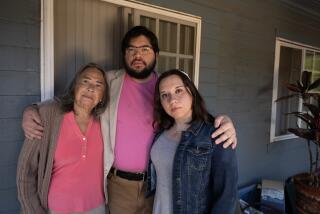Residents Given OK to Seal Off Crime-Ridden Alleys : Neighborhoods: Pilot project allows South-Central homeowners to use city property for recreational uses.
The narrow, unpaved alley behind Gwendolyn Stuart-Singleton’s house on West 49th Street is one of hundreds of alleys in South-Central Los Angeles that the city considers a nuisance to maintain.
But for longer than she cares to remember, Stuart-Singleton has viewed the unkempt, city-owned way with even greater alarm.
“It’s dangerous,” she said. “Whenever the dogs bark, you know that something’s going on back there that’s not right.”
The alley has been a popular place to dump a sofa or strip a stolen car. It has been a haven for the homeless, an easy escape route from the police and a convenient cover for prostitutes plying their trade and crack addicts seeking to score.
All this has frustrated residents of the well-kept homes surrounding the alley. They have struggled for years to drive unsavory elements out of the neighborhood without much success.
City officials say it cost nearly $4 million last year to clean up city alleys, with most of that spent in South-Central, where trash haulers routinely dump their loads illegally in lots and alleys to avoid landfill fees.
Recently, the City Council gave its blessing to a pilot project that would close off half a dozen such alleys in South-Central and turn the city-owned land over to the adjacent property owners for community gardens or other recreational uses.
“If the alleys are closed, then that will eliminate the illegal dumping, and close down the alley routes used by those who prey on the people with limited incomes,” said Charles Dickerson, president of the Board of Public Works.
Under the project, residents will be given permission to seal off access to the alleys, but they must pay for gates to block them, and they must assume responsibility for the maintenance and liability of the city-owned property.
“It’s a situation where everyone wins,” said Bob Hayes, a spokesman for the Department of Public Works. “We save money and it helps to make the communities remain safe.”
For years, safety concerns have led residents in scores of other neighborhoods throughout Los Angeles to seek city permission to erect gates or barricades on public streets. But the story of South-Central’s alleys is a distinctive one.
In many parts of the region, the alleys are so inaccessible that they are no longer used for garbage pickups and police and fire emergencies. Even homeowners do not enter their garages through the alleys, which have become clogged by the dumping.
“Most other parts of the city have no concept of how bad the problem of dumping is in the Central City,” Hayes said. “None of this dumping goes on in Brentwood and Westwood, where the alleys are improved. They don’t steal cars and take them to Brentwood to be torched.”
To help with the project, students from three classes at Cal Poly Pomona will survey alleys in South-Central’s 8th and 9th City Council districts and design some of the alternative uses for the residents to choose from.
“We have been kicking around a number of ideas,” said Charles M. Hotchkiss, chairman of urban and regional planning at the university. “We are looking at gardens, basketball hoops and picnic tables--anything that the neighbors determine will be useful to help improve their property.”
As many as 80 student volunteers are participating, determining which alleys would be most suited for withdrawal from public use. They will be identifying old, dirty alleys no more than 15 feet wide, located away from commercial areas and freeways and inaccessible to residents.
City officials estimate that as many as 100 alleys may be eligible.
Hotchkiss said the students will try to identify those neighborhoods where an alley beautification project will have the greatest possibility for success, and is supported by property owners who have a long-term stake in the community. Property owners must petition the city to withdraw the alley from public use.
The students began surveying the area Friday in city cars and will return for a closer look this week. “These neighborhoods look very nice,” said student Robert Poetsch, 24. “We were told to look for neighborhoods where people would have a stake in the program. That’s what we have here.”
Councilman Mark Ridley-Thomas, who represents the 8th District, said the program is one of many options needed to tackle the problem of illegal dumping.
Last year, he sponsored a utility fee increase that provided funds for the hiring of additional alley cleaning crews. Ridley-Thomas has also urged homeowners to become more involved by adopting alleys, posting signs and monitoring neighborhoods for illegal dumping. Ridley-Thomas has said the city needs to prosecute those who use the alleys as dumping grounds.
Illegal dumping has prompted many complaints in Councilwoman Rita Walter’s 9th District. “There are people who think the alleys are their private dumping ground,” she said.
In both Walters’ and Ridley-Thomas’ districts, a few have tried to close off their alleys.
Charles Brown persuaded his neighbors on 75th Street to close off the alley after one trash hauler dumped drums with toxic chemicals in it.
The residents circulated a petition. In January, they paid to install gates at both ends of the block. “The gates ended all the illegal dumping,” Brown said. “But then, we had another problem. No one has been willing to clear the weeds on their portion of the alley.”
On West 49th Street, Gwendolyn Stuart-Singleton said her neighbors plan to be more cooperative.
“We are all ready to go,” she said. “You get tired of calling the city to clean up the alley. As soon as the alley is closed off, I’m gonna put something nice back there. I’m gonna extend my property and put a garden back there.”
More to Read
Sign up for Essential California
The most important California stories and recommendations in your inbox every morning.
You may occasionally receive promotional content from the Los Angeles Times.










